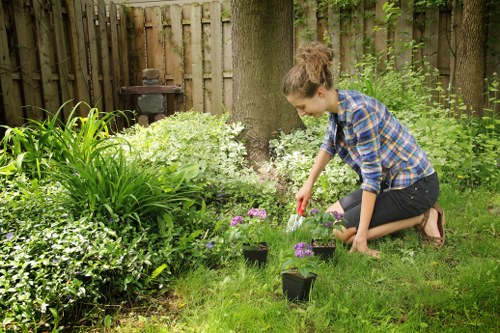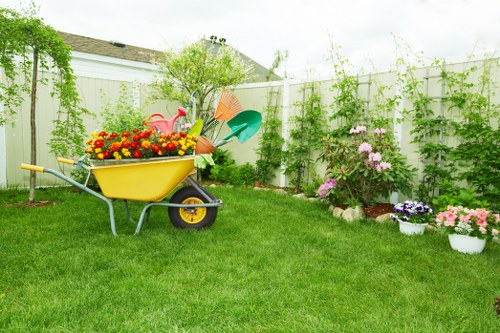Lawn Mowing in Grass Cutting: Achieving a Perfectly Manicured Yard

The Importance of Regular Lawn Mowing
Maintaining a well-manicured lawn is essential for enhancing the overall appearance of your property. Lawn mowing plays a crucial role in keeping your grass healthy and vibrant. Regular grass cutting helps in promoting even growth, preventing weeds, and ensuring that your yard remains a beautiful space for relaxation and entertainment.
Proper mowing techniques can significantly impact the health of your lawn. By cutting your grass to the appropriate height, you encourage deeper root growth, which in turn makes your lawn more resilient against drought and pests. Additionally, timely mowing reduces the likelihood of diseases that thrive in overgrown grass.
Consistency is key when it comes to lawn mowing. Establishing a mowing schedule based on your grass type and local climate conditions ensures that your lawn remains in top condition throughout the growing season.

Choosing the Right Mowing Equipment
Types of Lawn Mowers
Selecting the appropriate mower is essential for effective grass cutting. There are several types of lawn mowers available, each suited to different yard sizes and grass types:
- Push Mowers: Ideal for small to medium-sized lawns, push mowers are affordable and easy to maneuver.
- Ride-On Mowers: Suitable for large lawns, ride-on mowers offer comfort and efficiency for extensive grass cutting.
- Robotic Mowers: For those seeking convenience, robotic mowers automatically maintain your lawn with minimal effort.
- Electric vs. Gas-Powered: Electric mowers are eco-friendly and quieter, while gas-powered mowers provide more power for tougher mowing jobs.
Choosing the right mower depends on factors such as your budget, lawn size, and personal preferences. Investing in high-quality equipment can enhance the efficiency and quality of your lawn mowing routine.
Regular maintenance of your mower, including sharpening blades and checking for wear and tear, ensures optimal performance and extends the lifespan of your equipment.

Best Practices for Effective Lawn Mowing
Mowing Height and Frequency
Maintaining the correct mowing height is vital for a healthy lawn. Different grass types have varying optimal heights:
- Bermuda Grass: 1-2 inches
- Fescue Grass: 2.5-4 inches
- Zoysia Grass: 1-2 inches
- St. Augustine Grass: 2.5-4 inches
A general rule is to never remove more than one-third of the grass blade in a single mowing. This practice prevents stress on the grass and promotes lush, dense growth.
The frequency of mowing depends on the growth rate of your grass. During peak growing seasons, weekly mowing is typically necessary, while less frequent mowing may suffice during slower growth periods.
Implementing a sharp mower blade is crucial for clean cuts, reducing the risk of tearing the grass and preventing disease.
Proper Mowing Techniques
Adopting effective mowing techniques can greatly improve the health and appearance of your lawn:
- Alternate Mowing Directions: Changing the direction each time you mow prevents soil compaction and encourages upright grass growth.
- Edge Regularly: Neatly edging your lawn along sidewalks, driveways, and garden beds enhances the overall aesthetics.
- Avoid Mowing Wet Grass: Mowing when the grass is dry reduces clumping and ensures a clean cut.
- Leave Clippings on the Lawn: Grass clippings can act as a natural fertilizer, returning nutrients to the soil.

Seasonal Lawn Care and Mowing
Spring Lawn Mowing Tips
Spring is a critical period for lawn care. As temperatures rise and grass begins to grow, establishing a mowing routine is essential.
- Rake and Remove Debris: Clear any fallen leaves, twigs, or other debris to prevent obstruction during mowing.
- Fertilize: Applying a balanced fertilizer in spring promotes healthy growth and prepares your lawn for the growing season.
- Adjust Mowing Height: Gradually lowering the mowing height as the grass grows ensures optimal health.
Addressing weed control in the spring helps maintain a lush, weed-free lawn. Utilize pre-emergent herbicides to prevent weed seeds from germinating.
Summer Lawn Maintenance
Summer presents unique challenges for lawn care, primarily due to heat and potential drought conditions.
- Watering Strategies: Early morning watering reduces evaporation and allows grass to absorb moisture effectively.
- Mow Higher: Increasing the mowing height during summer provides shade to the roots and retains soil moisture.
- Monitor for Pests: Regular inspections can help identify and address pest issues before they cause significant damage.
Maintaining adequate soil moisture and avoiding over-fertilization are key to preventing lawn stress during the hot months.
Fall and Winter Lawn Care
As the growing season winds down, preparing your lawn for the colder months is essential.
- Final Mowing: Lower the mowing height slightly before the first frost to prepare the grass for dormancy.
- Leaf Management: Regularly remove fallen leaves to prevent them from smothering the grass.
- Aeration: Aerating the soil in the fall enhances root growth and improves nutrient uptake.
Applying a fall fertilizer can strengthen your lawn, making it more resilient against winter stress and promoting a vigorous comeback in the spring.

Common Lawn Mowing Mistakes to Avoid
Neglecting Blade Maintenance
One of the most common mistakes in lawn mowing is neglecting blade maintenance. Dull blades tear the grass instead of cutting it cleanly, leading to brown tips and increased susceptibility to disease.
- Regular Sharpening: Sharpen your mower blades at least once per mowing season, or more frequently if your lawn is especially thick.
- Balanced Blades: Ensure that mower blades are balanced to prevent vibrations and uneven cutting.
Mowing Too Short
Chemically known as “scalping,” mowing grass too short can severely damage your lawn. It removes too much of the leaf blade, reducing the plant’s ability to photosynthesize and weakening its overall health.
- Follow the One-Third Rule: Never remove more than one-third of the grass blade in a single mowing session.
- Adjust Mower Height: Set your mower to the appropriate height for your specific grass type.
Inconsistent Mowing Schedule
Skipping mowings or having an irregular schedule can lead to overgrown grass, which can harbor pests and weeds, and make mowing more challenging.
- Establish a Routine: Create a mowing schedule based on your grass growth rate and stick to it.
- Adapt to Growth Patterns: Adjust your mowing frequency according to seasonal growth changes.
Addressing Weeds and Pests
Ignoring weeds and pests can undermine your lawn care efforts. Implement integrated pest management strategies to keep these issues in check:
- Identify the Problem: Accurately determine the type of weed or pest affecting your lawn.
- Choose Appropriate Treatments: Use organic or chemical treatments as needed, following all safety guidelines.
- Prevent Future Infestations: Maintain healthy grass to naturally resist weeds and pests.
Regular monitoring and proactive measures are essential for maintaining a healthy lawn free from unwanted intruders.
Conclusion and Call to Action
Effective lawn mowing is fundamental to achieving and maintaining a beautiful, healthy yard. By understanding the importance of regular grass cutting, selecting the right equipment, and adhering to best practices, you can ensure your lawn remains a source of pride and enjoyment.
Don’t wait to transform your yard. Contact us today to schedule your professional lawn mowing service and experience the difference a well-maintained lawn can make!
Ready to elevate your outdoor space? Book your service now and let our experts help you achieve the perfect lawn you’ve always desired.

